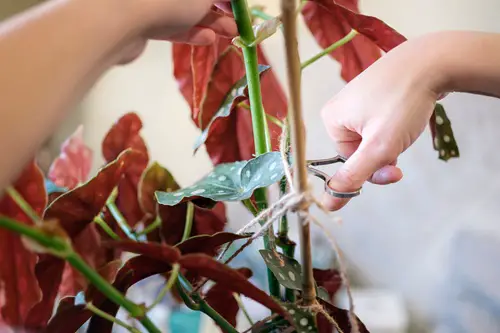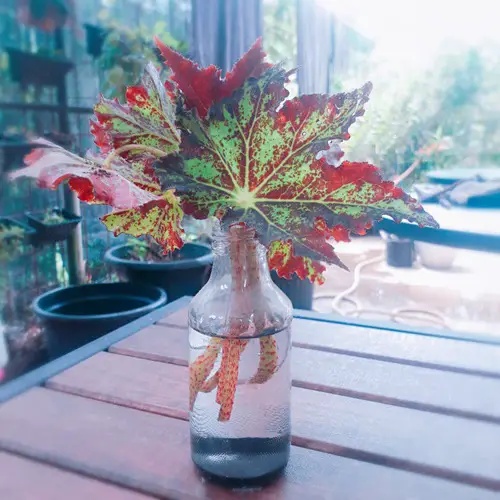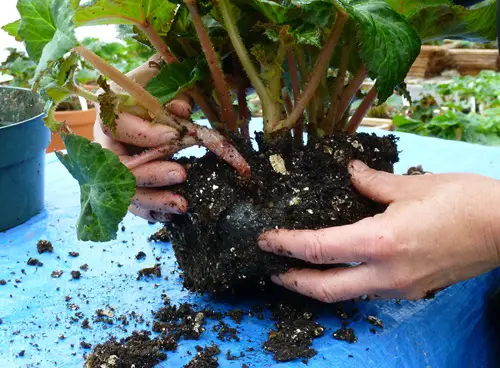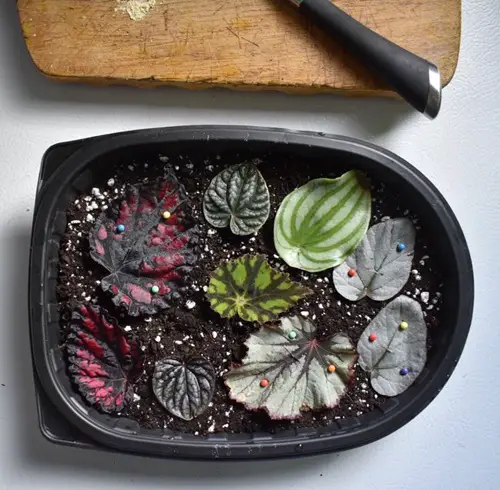Here are the best and easiest ways to Propagate Begonias that will help you multiply this plant in no time!

Propagating begonias can be a rewarding and cost-effective way to expand your collection. In this guide, you can find the best and simplest ways to propagate begonias to enjoy more of these lovely plants in your garden or indoor space.
Check out Gryphon Begonia Care and Growing Guide here
Understanding Begonias
Before discussing the specific propagation methods, let’s understand the two main types of begonias: tuberous begonias and fibrous-rooted begonias.
Tuberous begonias grow from tubers, while fibrous-rooted begonias have a more traditional root system. The propagation methods may vary slightly between these types, so it’s essential to identify your begonia type.
Propagating Begonias Using Stem Cuttings
Choose a healthy begonia plant with strong, disease-free stems. Cut a 4-6 inch stem section below a leaf node using sharp, clean scissors or pruning shears. Ensure there are at least two leaves on the cutting.
1. Preparing the Cutting
Remove any leaves from the lower part of the cutting, leaving only a couple at the top. This helps the cutting focus its energy on root development.
2. Planting
Plant the cutting in a well-draining potting mix (You can also apply a rooting hormone, but this is optional). Keep the soil consistently moist but not soggy.
Look at the Begonia Types & Varieties To Grow In Shade & Indoors
3. Cover With a Plastic Bag
Cover the cutting with a plastic bag to encourage root growth, or place it in a humidity dome. This helps maintain a humid environment around the cutting.
4. Transplanting
Once roots develop (usually in 2-4 weeks), transplant the new begonia plant into a larger container or directly into the garden.
Note: Early spring or fall (Whenever the weather feels warm) is the best time to take cuttings if you live in a cold climate. You can do this for temperate zones at any time of the year.
Look at the Begonia Maculata Varieties here
Water Propagation through Stem Cutting
Taking the cutting part is the same as above.
Once you have taken the cutting, plant it in a jar full of nonchlorinated water. Make sure the leaves do not touch it. Keep the jar/vase in an area with bright and indirect light, with a few hours of morning sun exposure.
Change the water every 3-4 days. The cuttings will form roots in 2-4 weeks – at this point, you can continue growing it in water or transplant it into soil.
Note: Water propagation can be done year-round.
Discover Top Rex Begonia Care and Growing Tips
Propagation by Division
The best time to divide begonias is in early spring. You can do it year-round indoors, and it works with all types of begonias.
1. Dividing the Plant
Gently lift the plant off the pot and shake the excess soil to see the tubers/roots properly. Now, divide them into sections, ensuring each has at least one eye (a small bud).
2. Planting
Dust the cut surface with a fungicide to prevent rot, and plant each section in a separate container or directly in the garden. Cover with soil and water lightly.
Keep the soil consistently moist until new shoots emerge. Once the new plants are established, treat them like mature begonias.
Find How to Grow Rex Begonia Vine Indoors
Propagation by Seeds
Begonia seeds are some of the smallest in the plant world, typically measuring about 1/300th of an inch (0.085 millimeters) in diameter, and can be easily mistaken for a fine powder. Sowing them can be a challenging task, requiring precision and care.
Get the seeds from an online seller or a garden center. Once you have them, scatter the seeds on the top of a seed starting mix and, using a spray bottle, water with 2-3 sprays. This will push them into the growing medium.
Cover them with plastic wrap and place them where they get plenty of bright and indirect light. The seeds will germinate in 3-6 weeks.
Learn Growing Elatior Begonia in this Guide
Propagation by Leaf Cutting
To start, carefully cut a healthy leaf, ensuring a bit of stem remains attached. Next, keep the leaf flat on the growing medium with a bit of stem tucked in the soil. Keep the pot where it gets plenty of indirect light.
Water only when the top soil feels dry to the touch using a spray bottle. Also, covering the pot with a plastic bag can create a humid environment, which is beneficial for root development.
In a few weeks, you should notice new growth emerging from the base of the leaf. For more details, you can read our article here.






